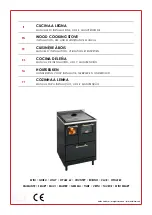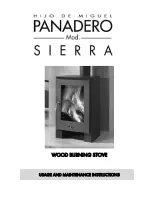
The advantages of metal chimneys are:
•
Easy installation.
•
Slight changes in chimney direction can be made, leading to greater flexibility
in the choice of location for the stove.
•
Due to there being curved elbow joint, sharp edges that make draught difficult
are removed.
C.- CONNECTING THE CHIMNEY
The flue of a lounge chimney is not very
recommendable for use as a chimney flue for a stove as it
has a very large section. If you wish to use it, we
recommend you use metal tubes on the inside with the
appropriate diameter.
In this case, one of the heads (we recommend the
upper head) must be covered to prevent the formation of
draught that may cool the smoke circulating along the metal
chimney.
(Fig.-2)
This model of HERGÓM stove has the smoke outlet
collar directed 45º in relation to the horizontal, which will
allow you to choose the most suitable direction, either
horizontal or vertical, by merely installing a 45º elbow joint.
(Fig. 5)
To connect the chimney
to the stove, lead the tube internally directly against the collar,
adjusting it to its conical shape and sealing the joint using
refractory filler to ensure its airtightness. (Fig. 3)
The joints of the remaining tubes forming the chimney, in
the event of using simple metal tubes, must be sealed using
refractory filler.
Ensure that all of the tubes in the chimney are well
fitted and that their joints are fully airtight.
When connecting the stove to the chimney, elbow joints and long horizontal sections
must be avoided as they make the draught difficult and favour the formation of creosote and
soot. Ensure that the connection is made at an upwards slant.
Tube Ø150 on inside
Fig.3
Fig.- 2
TAPAR
COVER
Fig. 4
Fig.-5






































